#sus domesticus
Explore tagged Tumblr posts
Note

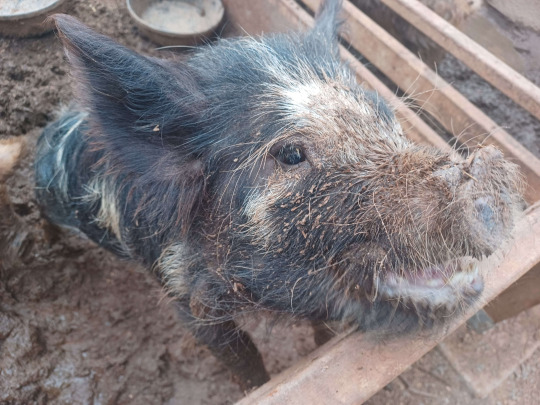
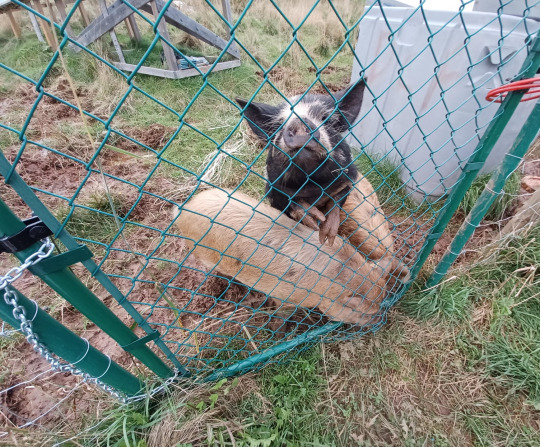
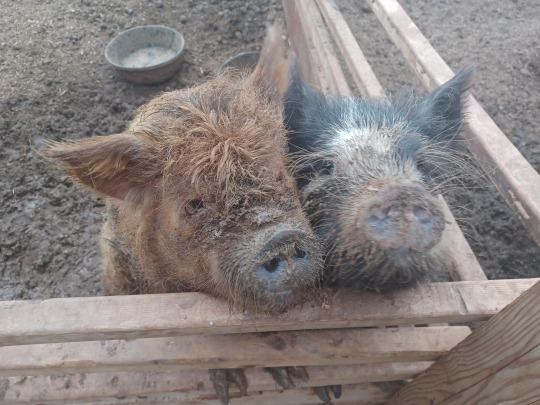
Oh my absolute god they're gorgeous
8 notes
·
View notes
Text

finally. a tumblr ad relevant to my interests
3 notes
·
View notes
Video
IMG_1112 by davemacnoodles59a Via Flickr: I took this shot of this Mangalitsa Pig ( Sus Scrofa domesticus ) when out for a wee walk around the Zoo during my wee London Trip September 2023 .... Copyright davemacnoodles59
#September 2023#Autumn Colours#Raw#My Wee London Trip September 2023#Nature#Shadows#Animals#Mammals#Big#Mangalitse Pig#Sus Scrofa domesticus#Mangaltisa Pig at London Zoo#Mangalitsa Pig in London#Mangalitsa Pig in England#Zoo#London Zoo#Zoo in London#Zoo in England#Zoo in Britain#Tourist Attraction#Visitor Attraction#London Attraction#England Attraction#Wee Walk`s#September Walk`s#Autumn Walk`s#Nature Walk`s#Zoo Walk`s#London Zoo Walk`s#London Walk`s
0 notes
Text
Idea that once human movies and tv series becomes accessible to the rest of the universe they immediately have to get re-called and re-regulated by the federation.
Like, the Andorians thought they had sexy romance shows, but then the terrans come along and now you've got angry zhavey's, shreya's, charan's, and thavan's calling in concerned on what their teenagers are watching.
And this especially applies to horror movies, Klingon space gets access to some classics and figure they'll sit around and laugh at the silly human horror. Cut to one Texas Chainsaw Massacre marathon later and now some human captain's are reporting that the Klingons are looking at them weirdly, like they almost seem... nervous of them?
Same thing goes for when Vulcans begin to approach human crewmates to ask how they manage to keep their children away from "The animated blue kanine and the female pink sus scrofa domesticus?"
Ferenginar just has a flatout ban against any and all talent/contest shows. To win profit just for having a talent? For showing good teamwork? Without any cheating or lying? Disgraceful media. (Although they would appreciate the trick of adding a sob backstory to gain more sympathy votes)
#star trek#humans are space orcs#humans are weird#klingons#vulcans#ferengi#andorians#humans are space oddities#humans are deathworlders#humans are space australians#star trek tos#star trek ds9#star trek tng#star trek voyager
2K notes
·
View notes
Note
Do you know how to come up with names for a fantasy race?
I've been trying to mix words but it comes out ugly sounding and looking. I've also tried to follow what we do in the real world, and use Greek words as suffixes, but whatever I combine it still comes out ugly... Help?
I've been trying to mix English+Greek, or just greek or just english.
Naming System For Your Fantasy Creatures/Races
Hey there, thanks for the ask! If English + Greek isn't working, try these combinations instead:
Greek + Latin
English + Latin (there will be a lot of overlaps)
French + English/Latin/Greek
Sanskrit + Greek + Latin
Latin has some pretty useful suffixes and prefixes, and it is the primary language used for flora/fauna scientific names (as well as in the periodic table, in fact!).
For inspiration, try searching up scientific names for random animals and flowers, which will help you discover some useful suffixes.
pig = Sus scrofa domesticus rose = Rosa rubiginosa > These already sound cooler than the average English name!
Examples:
Creature = Fire spitting elf with green skin Greek for fire = Fotia Latin suffix for elf = -pha Sanskrit for green = haritah -> Fictional Name = Haritah Fotipha (or just "Fotipha") or Haripha or Fortiah?
Creature = Water dragon Sanskrit for water = Jalam French for fly = lavion -> Fictional Name = Jalavion or Laviam?
When combining word, join them at the vowel for better flow.
Hope this helps! :)
─── ・ 。゚☆: *.☽ .* . ───
💎If you like my blog, buy me a coffee☕ and find me on instagram!
💎Before you ask, check out my masterpost part 1 and part 2
💎For early access to my content and priority questions, become a Writing Wizard
#writing#writers and poets#creative writing#writeblr#helping writers#let's write#creative writers#poets and writers#writers on tumblr#resources for writers#character names#character development#writing practice#writing prompt#writing inspiration#writing community#writing ideas#on writing#writing advice#writer#writer stuff#fantasy names
315 notes
·
View notes
Text

Arson (16) Male, year 10
- Omnivore
- Sus domesticus (Pig)
- 167 cm 90 kilos
- Soft-spoken fella whose family moved to Japan from the US and doesn't speak a lick of the language. Trying his darndest, that's for sure
Hunter (17) Male, year 10
- Carnivore
- Lycaon pictus x Hyena hyena mix
- 170 cm 60 kilos
- Dark humoured and joyful despite (or maybe as a result if) having been convicted for a crime he didn't commit. Because of his age at the time and pleading guilty, he got the smaller punishment which forced him to wear a muzzle in public. Rarely seen without it, loves to collect metal and glassware.
15 notes
·
View notes
Text



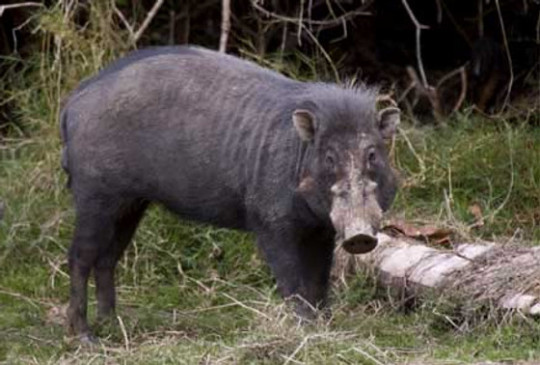
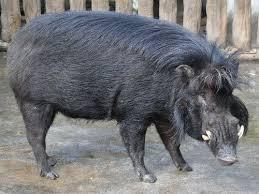




#poll#random poll#fun polls#poll time#my polls#tumblr polls#random polls#polls#tumblr poll#fandom polls#polls on tumblr#polls polls polls#polls are fun#pig#wild boar#animal#animals#fauna#cute animals#Palawan bearded pig#Sus ahoenobarbus#Bornean bearded pig#Sus barbatus#Visayan warty pig#Sus cebifrons#Celebes warty pig#Sus celebensis#Oliver's warty pig#Sus oliveri#Philippine warty pig
16 notes
·
View notes
Text

INKTOBER 2023 Day 28 - Pig (Sus domesticus)
Patreon / Ko-fi / Society6 / Redbubble / Commissions / Colouring book
33 notes
·
View notes
Text

Domestic Pig (Mangalica) (Sus domesticus) - (c) SaritaWolf - please do not repost
2 notes
·
View notes
Text
classifying mobs 4
im back! time for pt 4! today we will discuss piglins, aquatics and enders!
(camel here. it seems i forgot the piglin bosses from minecraft legends. i forgot to add them to the boss/mini boss category. sry bout that!)
the piglins are.... a weird bunch. we wont talk about Sus scrofa domesticus (average pigs), we will talk abt Sus scrofa carnivora (the scientific name i gave to the piglin/hoglins). being able walk on two feet, intelligent and have a love of gold, the piglins are a iconic bunch. reminiscent of orcs from modern fantasy, they carry weapons made of cold and are deadly in a group. lets take a look.
Sus scrofa carnivora/piglins and hoglins: fungus thrower, piglin, piglin hunter, zombifies fungus thrower, zombified piglin, zombified piglin hunter, hoglin, unstoppable tusk, ancient piglin/fungus thrower/hunter, blaze runt, brute, clanger, lava launcher, mace runt, piglin builder, pigmadillo, portal guard, seeker, spore medic, spore back, war boar, the great og, the beast, the devourer, the unbreakable, ancient hoglin, the seer, pigman, zombie pigman, zoglin.
next are cephalopods and aquatics creatures. they are the squids, ocotpuses, cuttle fish, guardians and more of the minecraft world. lets do this.
aquatics: squids, glow squids, guardians, elder guardians, barnacle, crab, wave whisperer, tropical slime, fishes, clam, eponymous squid, and more.
finally the enders. no given name to these silly bois so i gave them a scientific name based on the human turned into enderman theory (the scientific name will only include humanoid enders.) meet: Homo enderian.
enders: enderman, ender dragon, shulker, endermite, blastling, snareling, watchling, endersent, the swarm, the watcher of the end, heart of ender, vengeful heart of ender, imperfect heart of ender, ancient enderman (looming doom), icy ender creeper and giant enderman.
ok bonus. this is a weird one but a short one.
humanoids: villagers, illagers, NPC, monster, mob of me, beast boy, black steve, rana, steve, rascal, pigman, piglins, ray tracing, mobbo, minecraft dungeons heroes, (they exist in the lore) steve villager hybrid (found in the original wiki), warrior.
see you in pt 5!
8 notes
·
View notes
Text
All animal species (and a couple algae) that have kept the same scientific name since Linnaeus
The first work of taxonomy that is considered as having any scientific authority for animal species was the 10th edition of Linnaeus' Systema Naturae, published in 1758. (Also a book on spiders called Aranei Suecici, published one year before.) That's the foundational text of the binominal system of nomenclature of species still in use today. Since then most of Linnaeus' original species (4379 species, of which 185 mammals, 554 birds, 217 "amphibians" (including reptiles and cartilaginous fish), 379 fishes, 2104 "insects" (including various arthropods, of which 664 are beetles and 543 are moths & butterflies crammed into only 3 genera), and 940 "worms" (including basically all other invertebrates, and even some protists and algae)) have been dismembered, renamed, or at least moved to different genera (e.g. the house sparrow went from Fringilla domestica to Passer domesticus).
Here is a list of all of Linnaeus' original species from 1758 that still retain their original name. I believe they are 484 in total.
"Mammalia"
(Primates)
Homo sapiens (human)
Lemur catta (ring-tailed lemur)
Vespertilio murinus (rearmouse bat)
(Bruta)
Elephas maximus (Asian elephant)
Trichechus manatus (West Indian manatee)
Bradypus tridactylus (three-toed sloth)
Myrmecophaga tridactyla (giant anteater)
Manis pentadactylus (Chinese pangolin)
(Ferae)
Phoca vitulina (harbor seal)
Canis familiaris (dog)
Canis lupus (grey wolf)
Felis catus (house cat)
Viverra zibetha (Indian civet)
Mustela erminea (stoat)
Mustela furo (ferret)
Mustela lutreola (European mink)
Mustela putorius (wild ferret)
Ursus arctos (brown bear)
(Bestiae)
Sus scrofa (wild boar/pig)
Dasypus septemcinctus (seven-banded armadillo)
Dasypus novemcinctus (nine-banded armadillo)
Erinaceus europaeus (European hedgehog)
Talpa europaea (European mole)
Sorex araneus (common shrew)
Didelphis marsupialis (common opossum)
(Glires)
Rhinoceros unicornis (Indian rhinoceros)
Hystrix brachyura (Malayan porcupine)
Hystrix cristata (crested porcupine)
Lepus timidus (common hare)
Castor fiber (European beaver)
Mus musculus (house mouse)
Sciurus vulgaris (red squirrel)
(Pecora)
Camelus dromedarius (dromedary camel)
Camelus bactrianus (Asian camel)
Moschus moschiferus (musk deer)
Cervus elaphus (red deer)
Capra hircus (goat)
Capra ibex (Alpine ibex)
Ovis aries (sheep)
Bos taurus (cow)
Bos indicus (zebu)
(Belluae)
Equus caballus (horse)
Equus asinus (donkey)
Equus zebra (mountain zebra)
Hippopotamus amphibius (hippopotamus)
(Cete)
Monodon monoceros (narwhal)
Balaena mysticetus (bowhead whale)
Physeter macrocephalus (sperm whale)
Delphinus delphis (common dolphin)
"Aves"
(Accipitres)
Vultur gryphus (Andean condor)
Falco tinnunculus (common kenstrel)
Falco sparverius (sparrowhawk)
Falco columbarius (pigeonhawk)
Falco subbuteo (Eurasian hobby)
Falco rusticolus (gyrfalcon)
Strix aluco (tawny owl)
Lanius excubitor (great grey shrike)
Lanius collurio (red-backed shrike)
Lanius schach (long-tailed shrike)
(Picae)
Psittacus erithacus (grey parrot)
Ramphastos tucanus (white-throated toucan)
Buceros bicornis (great hornbill)
Buceros rhinoceros (rhinoceros hornbill)
Crotophaga ani (smooth-billed ani)
Corvus corax (raven)
Corvus corone (carrion crow)
Corvus frugilegus (rook)
Corvus cornix (hooded crow)
Coracias oriolus (golden oriole)
Coracias garrulus (European roller)
Gracula religiosa (hill myna)
Paradisaea apoda (greater bird-of-paradise)
Cuculus canorus (common cuckoo)
Jynx torquilla (wryneck)
Picus viridis (green woodpecker)
Sitta europaea (Eurasian nuthatch)
Merops apiaster (European bee-eater)
Merops viridis (blue-throated bee-eater)
Upupa epops (Eurasian hoopoe)
Certhia familiaris (Eurasian treecreeper)
Trochilus polytmus (red-billed streamertail hummingbird)
(Anseres)
Anas platyrhynchos (mallard duck)
Anas crecca (teal duck)
Mergus merganser (common merganser)
Mergus serrator (red-breasted merganser)
Alca torda (razorbill auk)
Procellaria aequinoctialis (white-chinned petrel)
Diomedea exulans (wandering albatross)
Pelecanus onocrotalus (great white pelican)
Phaeton aethereus (red-billed tropicbird)
Larus canus (common gull)
Larus marinus (great black-backed gull)
Larus fuscus (lesser black-backed gull)
Sterna hirundo (common tern)
Rhynchops niger (black skimmer)
(Grallae)
Phoenicopterus ruber (American flamingo)
Platalea leucorodia (Eurasian spoonbill)
Platalea ajaia (roseate spoonbill)
Mycteria americana (wood stork)
Ardea cinerea (grey heron)
Ardea herodias (blue heron)
Ardea alba (great egret)
Scolopax rusticola (Eurasian woodcock)
Charadrius hiaticula (ringed plover)
Charadrius alexandrinus (Kentish plover)
Charadrius vociferus (killdeer plover)
Charadrius morinellus (Eurasian dotterel)
Recurvirostra avosetta (pied avocet)
Haematopus ostralegus (Eurasian oystercatcher)
Fulica atra (Eurasian coot)
Rallus aquaticus (water rail)
Psophia crepitans (grey-winged trumpeter)
Otis tarda (great bustard)
Struthio camelus (ostrich)
(Gallinae)
Pavo cristatus (Indian peafowl)
Meleagris gallopavo (wild turkey)
Crax rubra (great curassow)
Phasianus colchicus (common pheasant)
Tetrao urogallus (western capercaillie)
(Passeres)
Columba oenas (stock dove)
Columba palumbus (wood pigeon)
Alauda arvensis (Eurasian skylark)
Sturnus vulgaris (European starling)
Turdus viscivorus (mistle thrush)
Turdus pilaris (fieldfare thrush)
Turdus iliacus (redwing thrush)
Turdus plumbeus (red-legged thrush)
Turdus torquatus (ring ouzel)
Turdus merula (blackbird)
Loxia curvirostra (crossbill)
Emberiza hortulana (ortolan bunting)
Emberiza citrinella (yellowhammer)
Emberiza calandra (corn bunting)
Fringilla coelebs (common chaffinch)
Motacilla alba (white wagtail)
Motacilla lava (yellow wagtail)
Parus major (great tit)
Hirundo rustica (barn swallow)
Caprimulgus europaeus (European nightjar)
"Amphibia"
(Reptiles)
Testudo graeca (Greek tortoise)
Draco volans (flying dragon)
Lacerta agilis (sand lizard)
Rana temporaria (common frog)
(Serpentes)
Crotalus horridus (timber rattlesnake)
Crotalus durissus (tropical rattlesnake)
Boa constrictor (common boa)
Coluber constrictor (eastern racer)
Anguis fragilis (slowworm)
Amphisbaena alba (red worm lizard)
Caecilia tentaculata (white-bellied caecilian)
(Nantes)
Petromyzon marinus (sea lamprey)
Raja clavata (thornback ray)
Raja miraletus (brown ray)
Squalus acanthias (spiny dogfish)
Chimaera monstrosa (rabbitfish)
Lophius piscatorius (anglerfish)
Acipenser sturio (sea sturgeon)
Acipenser ruthenus (sterlet sturgeon)
"Pisces"
(Apodes)
Muraena helena (Mediterranean moray)
Gymnotus carapo (banded knifefish)
Trichiurus lepturus (cutlassfish)
Anarhichas lupus (Atlantic wolffish)
Ammodytes tobianus (lesser sandeel)
Xiphias gladius (swordfish)
Stromateus fiatola (blue butterfish)
(Jugulares)
Callionymus lyra (common dragonet)
Uranoscopus scaber (stargazer)
Trachinus draco (greater weever)
Gadus morhua (Atlantic cod)
Blennius ocellaris (butterfly blenny)
Ophidion barbatum (snake cusk-eel)
(Thoracici)
Cyclopterus lumpus (lumpsucker)
Echeneis naucrates (sharksucker)
Coryphaena equiselis (pompano)
Coryphaena hippurus (dorado)
Gobius niger (black goby)
Govius paganellus (rock goby)
Cottus gobio (European bullhead)
Scorpaena porcus (black scorpionfish)
Scorpaena scrofa (red scorpionfish)
Zeus faber (John Dory)
Pleuronectes platessa (European plaice)
Chaetodon striatus (banded butterflyfish)
Chaetodon capistratus (foureye butterflyfish)
Sparus aurata (gilt-head bream)
Labrus merula (brown wrasse)
Labrus mixtus (cuckoo wrasse)
Labrus viridis (green wrasse)
Sciaena umbra (brown meagre)
Perca fluviatilis (European perch)
Gasterosteus aculeatus (three-spined stickleback)
Scomber scombrus (Atlanti mackerel)
Mullus barbatus (red mullet)
Mullus surmuletus (surmullet)
Trigla lyra (piper gurnard)
(Abdominales)
Cobitis taenia (spined loach)
Silurus asotus (Amur catfish)
Silurus glanis (Wels catfish)
Loricaria cataphracta (suckermouth catfish)
Salmo carpio (Garda trout)
Salmo trutta (brown trout)
Salmo salar (Atlantic salmon)
Fistularia tabacaria (bluespotted cornetfish)
Esox lucius (northern pike)
Argentina sphyraena (European argentine)
Atherina hepsetus (Mediterranean sand smelt)
Mugil cephalus (flathead mullet)
Exocoetus volitans (tropical flying fish)
Polynemus paradiseus (Paradise threadfin)
Clupea harengus (Atlantic herring)
Cyprinus carpio (common carp)
(Branchiostegi)
Mormyrus caschive (bottlenose elephantfish)
Balistes vetula (queen triggerfish)
Ostracion cornutus (longhorn cowfish)
Ostracion cubicus (yellow boxfish)
Tetraodon lineatus (Fahaka pufferfish)
Diodon hystrix (spot-fin porcupinefish)
Diodon holocanthus (long-spine porcupinefish)
Centriscus scutatus (grooved shrimpfish)
Syngnathus acus (common pipefish)
Syngnathus pelagicus (pelagic pipefish)
Syngnathus typhle (broad-nosed pipefish)
Pegasus volitans (longtail seamoth)
"Insecta"
(Coleoptera)
Scarabaeus sacer (sacred scarab)
Dermestes lardarius (larder beetle)
Dermestes murinus (larder beetle)
Hister unicolor (clown beetle)
Hister quadrimaculatus (clown beetle)
Silpha obscura (carrion beetle)
Cassida viridis (tortoise beetle)
Cassida nebulosa (tortoise beetle)
Cassida nobilis (tortoise beetle)
Coccinella trifasciata (ladybug)
Coccinella hieroglyphica (ladybug) [Coccinella 5-punctata, 7-punctata, 11-punctata, and 24-punctata survive as quinquepunctata, septempunctata, undecimpunctata, and vigintiquatorpunctata]
Chrysomela populi (leaf beetle)
Chrysomela lapponica (leaf beetle)
Chrysomela collaris (leaf beetle)
Chrysomela erythrocephala (leaf beetle)
Curculio nucum (nut weevil)
Attelabus surinamensis (leaf-rolling weevil)
Cerambyx cerdo (capricorn beetle)
Leptura quadrifasciata (longhorn beetle)
Cantharis fusca (soldier beetle)
Cantharis livida (soldier beetle)
Cantharis oscura (soldier beetle)
Cantharis rufa (soldier beetle)
Cantharis lateralis (soldier beetle)
Elater ferrugineus (rusty click beetle)
Cicindela campestris (green tiger beetle)
Cicindela sylvatica (wood tiger beetle)
Buprestis rustica (jewel beetle) [Buprestis 8-guttata survives as octoguttata]
Dytiscus latissimus (diving beetle)
Carabus coriaceus (ground beetle)
Carabus granulatus (ground beetle)
Carabus nitens (ground beetle)
Carabus hortensis (ground beetle)
Carabus violaceus (ground beetle)
Tenebrio molitor (mealworm)
Meloe algiricus (blister beetle)
Meloe proscarabaeus (blister beetle)
Meloe spec (blister beetle)
Mordela aculeata (tumbling glower beetle)
Necydalis major (longhorn beetle)
Staphylinus erythropterus (rove beetle)
Forficula auricularia (common earwig)
Blatta orientalis (Oriental cockroach)
Gryllus campestris (field cricket)
(Hemiptera)
Cicada orni (cicada)
Notonecta glauca (backswimmer)
Nepa cinerea (water scorpion)
Cimex lectularius (bedbug)
Aphis rumici (black aphid)
Aphis craccae (vetch aphid)
Coccus hesperidum (brown scale insect)
Thrips physapus (thrips)
Thrips minutissimum (thrips)
Thrips juniperinus (thrips)
(Lepidoptera)
Papilio paris (Paris peacock butterfly)
Papilio helenus (red Helen butterfly)
Papilio troilus (spicebush swallowtail butterfly)
Papilio deiphobus (Deiphobus swallowtail butterfly)
Papilio polytes (common Mormon butterfly)
Papilio glaucus (eastern tiger swallowtail butterfly)
Papilio memnon (great Mormon butterfly)
Papilio ulysses (Ulysses butterfly)
Papilio machaon (Old World swallowtail butterfly)
Papilio demoleus (lime swallowtail butterfly)
Papilio nireus (blue-banded swallowtail butterfly)
Papilio clytia (common mime butterfly)
Sphinx ligustri (privet hawk-moth)
Sphinx pinastri (pine hawk-moth) [genus Phalaena was suppressed, but seven subgenera created by Linnaeus are now valid as genera]
(Neuroptera)
Libellula depressa (chaser dragonfly)
Libellula quadrimaculata (four-spotted skimmer dragonfly)
Ephemera vulgata (mayfly)
Phryganea grandis (caddisfly)
Hemerobius humulinus (lacewing)
Panorpa communis (scorpionfly)
Panorpa germanica (scorpionfly)
Raphidia ophiopsis (snakefly)
(Hymenoptera)
Cynips quercusfolii (oak gall wasp)
Tenthredo atra (sawfly)
Tenthredo campestris (sawfly)
Tenthredo livida (sawfly)
Tenthredo mesomela (sawfly)
Tenthredo scrophulariae (sawfly)
Ichneumon extensorius (parasitoid wasp)
Ichneumon sarcitorius (parasitoid wasp)
Sphex ichneumoneus (digger wasp)
Vespa crabro (European hornet)
Apis mellifera (honey bee)
Formica fusca (silky ant)
Mutilla europaea (large velvet ant)
(Diptera)
Oestrus ovis (sheep botfly)
Tipula oleracea (marsh cranefly)
Tipula hortorum (cranefly)
Tipula lunata (cranefly)
Musca domestica (housefly)
Tabanus bovinus (pale horsefly)
Tabanus calens (horsefly)
Tabanus bromius (brown horsefly)
Tabanus occidentalis (horsefly)
Tabanus antarcticus (horsefly)
Culex pipiens (house mosquito)
Empis borealis (dance fly)
Empis pennipes (dance fly)
Empis livida (dance fly)
Conops flavipes (thick-headed fly)
Asilus barbarus (robberfly)
Asilus crabroniformis (hornet robberfly)
Bombylius major (bee fly)
Bombylius medius (bee fly)
Bombylius minor (bee fly)
Hippobosca equina (forest fly)
(Aptera)
Lepisma saccharina (silverfish)
Podura aquatica (water springtail)
Termes fatale (termite)
Pediculus humanus (human louse)
Pulex irritans (human flea)
Acarus siro (flour mite)
Phalangium opilio (harvestman)
Araneus angulatus (orb-weaving spider)
Araneus diadematus (European garden spider)
Araneus marmoreus (marbled orbweaver)
Araneus quadratus (four-spotted orbweaver -- last four are by Clerck 1757, some of the very few surviving pre-Linnean names!)
Scorpio maurus (large-clawed scorpion)
Cancer pagurus (brown crab)
Oniscus asellus (common woodlouse)
Scolopendra gigantea (giant centipede)
Scolopendra morsitans (red-headed centipede)
Julus fuscus (millipede)
Julus terrestris (millipede)
"Vermes"
(Intestina)
Gordius aquaticus (horsehair worm)
Lumbricus terrestris (common earthworm)
Ascaris lumbricoides (giant roundworm)
Fasciola hepatica (liver fluke)
Hirudo medicinalis (medicinal leech)
Myxine glutinosa (Atlantic hagfish)
Teredo navalis (shipworm)
[shout out to Furia infernalis, a terrifying carnivorous jumping worm that Linnaeus described, but which doesn't seem to actually exist]
(Mollusca)
Limax maximus (leopard slug)
Doris verrucosa (warty nudibranch)
Nereis caerulea (ragworm)
Nereis pelagica (ragworm)
Aphrodita aculeata (sea mouse)
Lernaea cyprinacea (anchor worm)
Scyllaea pelagica (Sargassum nudibranch)
Sepia officinalis (common cuttlefish)
Asterias rubens (common starfish)
Echinus esculentus (edible sea urchin)
(Testacea)
Chiton tuberculatus (West Indian green chiton)
Lepas anatifera (goose barnacle)
Pholas dactylus (common piddock)
Mya arenaria (softshell clam)
Mya truncata (truncate softshell)
Solen vagina (razor clam)
Tellina laevigata (smooth tellin)
Tellina linguafelis (cat-tongue tellin)
Tellina radiata (sunrise tellin)
Tellina scobinata (tellin)
Cardium costatum (ribbed cockle)
Donax cuneatus (wedge clam)
Donas denticulatus (wedge clam)
Donax trunculus (wedge clam)
Venus casina (Venus clam)
Venus verrucosa (warty venus)
Spondylus gaederopus (thorny oyster)
Spondylus regius (thorny oyster)
Chama lazarus (jewel box shell)
Chama gryphoides (jewel box shell)
Arca noae (Noah's ark shell)
Ostrea edulis (edible oyster)
Anomia aurita (saddle oyster)
Anomia ephippium (saddle oyster)
Anomia hysterita (saddle oyster)
Anomia lacunosa (saddle oyster)
Anomia spec (saddle oyster)
Anomia striatula (saddle oyster)
Mytilus edulis (blue mussel)
Pinna muricata (pen shell)
Pinna nobilis (fan mussel)
Pinna rudis (rough pen shell)
Argonauta argo (argonaut)
Nautilus pompilius (chambered nautilus)
Conus ammiralis (admiral cone snail)
Conus aulicus (princely cone snail)
Conus aurisiacus (cone snail)
Conus betulinus (betuline cone snail)
Conus bullatus (bubble cone snail)
Conus capitaneus (captain cone snail)
Conus cedonulli (cone snail)
Conus ebraeus (black-and-white cone snail)
Conus figulinus (fig cone snail)
Conus genuanus (garter cone snail)
Conus geographus (geographer cone snail)
Conus glaucus (glaucous cone snail)
Conus granulatus (cone snail)
Conus imperialis (imperial cone snail)
Conus litteratus (lettered cone snail)
Conus magus (magical cone snail)
Conus marmoreus (marbled cone snail)
Conus mercator (trader cone snail)
Conus miles (soldier cone snail)
Conus monachus (monastic cone snail)
Conus nobilis (noble cone snail)
Conus nussatella (cone snail)
Conus princeps (prince cone snail)
Conus spectrum (spectrecone snail)
Conus stercusmuscarum (fly-specked cone snail)
Conus striatus (striated cone snail)
Conus textile (cloth-of-gold cone snail)
Conus tulipa (tulip cone snail)
Conus varius (freckled cone snail)
Conus virgo (cone snail)
Cypraea tigris (tiger cowry shell)
Bulla ampulla (Pacific bubble shell)
Voluta ebraea (Hebrew volute)
Voluta musica (music volute)
Buccinum undatum (common whelk)
Strombus pugilis (fighting conch)
Murex tribulus (caltrop murex)
Trochus maculatus (maculated top shell)
Turbo acutangulus (turban shell)
Turbo argyrostomus (silver-mouth turban shell)
Turbo chrystostomus (gold-mouth turban shell)
Turbo marmoratus (green turban shell)
Turbo petholatus (turban shell)
Turbo sarmaticus (giant turban shell)
Helix lucorum (Mediterranean snail)
Helix pomatia (Roman snail)
Nerita albicilla (blotched nerite)
Nerita chamaeleon (nerite)
Nerita exuvia (snakeskin nerite)
Nerita grossa (nerite)
Nerita histrio (nerite)
Nerita peloronta (bleeding tooth)
Nerita plicata (nerite)
Nerita polita (nerite)
Nerita undata (nerite)
Haliotis asinina (ass-ear abalone)
Haliotis marmorata (marbled abalone)
Haliotis midae (South African abalone)
Haliotis parva (canaliculate abalone)
Haliotis tuberculata (green ormer)
Haliotis varia (common abalone)
Patella caerulea (Mediterranean limpet)
Patella pellucida (blue-rayed limpet)
Patella vulgata (European limpet)
Dentalium elephantinum (elephant tusk)
Dentalium entale (tusk shell)
[genus Serpula is still in use with none of its original species]
(Lithophyta)
Tubipora musica (organ pipe coral)
Millepora alcicornis (sea ginger fire coral)
Madrepora oculata (zigzag stone coral)
(Zoophyta)
Isis hippuris (sea bamboo)
Isis ochracea (sea bamboo)
Gorgonia flabellum (Venus fan)
Gorgonia ventalina (purple sea fan)
Alcyonium bursa (soft coral)
Alcyonium digitatum (dead man's fingers)
Tubularia indivisa (oaten ipes hydroid)
Corallina officinalis (coralline red alga)
Sertularia argentea (sea fern)
Sertularia cupressoides (hydroid)
Pennatula phosphorea (sea pen)
Taenia solium (pork tapeworm)
Volvox globator (colonial alga)
[genus Hydra is still in use with none of its original species]
15 notes
·
View notes
Text

Domestic Pig ( Sus domesticus) notecards by Linda Cook DeVona
2 notes
·
View notes
Text
#2278 - Sus domesticus - Domestic Pig

Pigs were first domesticated in the Neolithic, and are raised in many parts of the world for meat and leather. They were first introduced to New Zealand in 1769 when the French explorer Jean-François de Surville gave a pair to the Maori at Doubtless Bay. Between 1773 and 1777 Captain James Cook released nine pigs and gave another seven to the locals, and his name is the one that stuck to their descendents - 'Captain Cookers'.
The feral pigs are as huge a problem in New Zealand as they are everywhere else they've gone wild, but at the time pigs and potatoes were a revolution in Maori agriculture. As well as being an excellent source of meat, they and New Zealand Flax were valuable trades good for visiting ships. Unfortunately, one of the trade goods they got back was musketry, and between 1806 and 1845 there was an escalating arms race and thousands of battles known as the Musket Wars, where various iwi attacked neighbouring iwi, taking the survivors as slaves to grow more flax, to trade for more guns. Between 1845 and 1872 came the New Zealand Wars, in which the British frequently got their asses handed to them.
New Zealand does have one breed of domestic pig, the kunekune, probably derived from an Asian domestic breed introduced in the early 19th century by whalers or traders. I'm not sure if this one is a kunukune.
Tokaanu, Taupo Volcanic Zone, New Zealand
2 notes
·
View notes
Note
Hogs are Sus! (Sus Domesticus)
yep they sure are! artiodactyla is the order, not the genus
♡loop
5 notes
·
View notes
Text

Oeuvre d'Ada Breedveld
#30 jours pour écrire / VULGAIRE
Un petit cochon
en son habit vulgaire
allait voir sa mie
*
Son amoureuse
du même acabit que lui
est pourtant lettrée
*
A longueur de temps
elle voulait qu'ils s'élèvent
au dessus des gens
*
Tout triste et lassé
sus scrofa domesticus
finit par la manger
*
La moralité
c'est que grand cochon tu es
grand porc tu restes...
(La bouquiniste) Haïkus
19 notes
·
View notes
Text
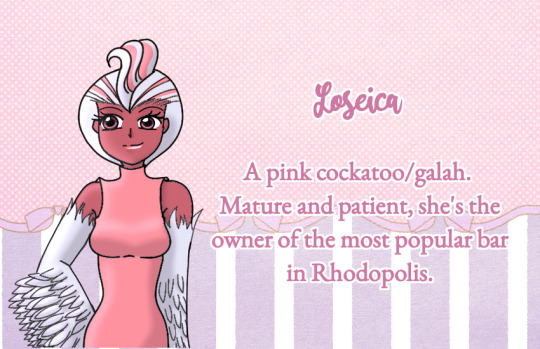


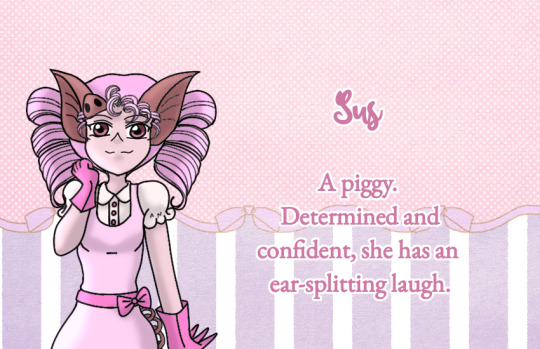
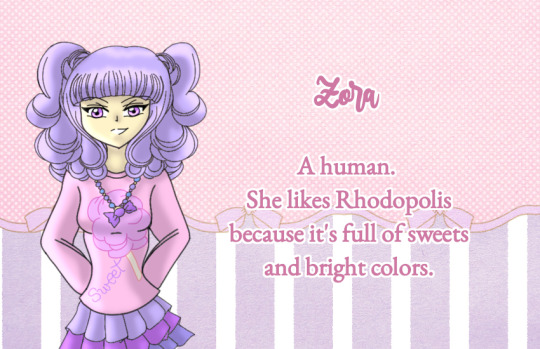
Texture: m i t s u
Chantal's clients!
Will she be able to give them customized sweets while avoiding everything they hate? Hopefully yes, because otherwise her reputation as a great pastry chef would suffer a serious blow-
Their names come from the scientific names of the animals they are inspired by:
Loseica: Pink cockatoo/Galah - Eo[lo]phus ro[seica]pilla
Kenicea: Hopkin's rose nudibranch - O[keni]a rosa[cea]
Silsdia: Pink handfish - Brachiop[sil]u[s dia]nthus
Sus: Piggy - [Sus] domesticus
And Zora, from "roza", "pink" in Esperanto.
Yes, there's even a human. In Rhodopolis you can really find everything.
Regarding their designs, Sus and Zora fall into Harajuku Fashion, with the former inspired by classic lolita (Because she is an ojousama) and the latter by fairy kei (Because she is the only human, so she is inspired by a supernatural creature (?)).
Silsdia, on the other hand, is more "granny style" (No flying slipper, but she can flip your face with a pat), while Loseica is more of a very light elegant punk (She's a career woman who doesn't give up fashion!).
Kenicea is a tentacled blob in a furry dress. Obviously you can't see it from the bust, but she's the only other character besides Janet to have more than two legs - Many, many more.
2 notes
·
View notes